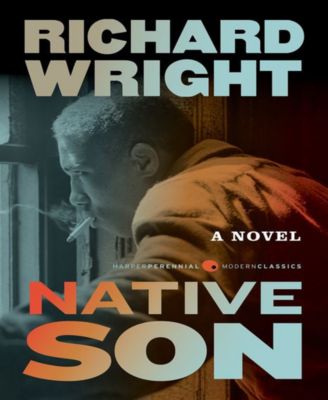Native Son by Richard Wright
Product details
Web ID: 16777928Aw ok....
"Native Son" remains a seminal work in American literature. It hauntingly explores the intersection of race, class, and violence. Its relevance continues to resonate today, making it an essential read for anyone seeking to understand the complexities of racial dynamics in America. Wright's exploration of Bigger Thomas's life is a stark reminder of the enduring impact of systemic oppression and the urgent need for societal change. At the end of the day, a person is in control of their actions no matter the person, environment, etc.
Recommends this product

Customer review from barnesandnoble.com
Great book a must read
Native Son by: Richard Wright, Historical Fiction The repeated theme of Native son is the ongoing place of fear implemented into the People of color. Driven by it the Mc commits murder through fear. Bigger is a 22 year old man black man who has committed a grave crime. Bigger lives a life of chaos yet symplicity. Bigger is a chaotic soul and bad luck seems to follow him like a lost puppy. It seems like he can never catch a break. It all starts with a new job with a rich white family. This family’s vibes seem off to him but takes the job for the high pay and his own room . His job is simple: just drive the family around and take them home after. His first time driving is with the daughter, a pretty thing but something about her makes Bigger's blood boil. He is supposed to take her to her night classes but she tells him that she would like to pick up her boyfriend and to take them to a place Bigger would like to eat. The air soon becomes stiff and Bigger becomes awkward. After taking the daughter and her boyfriend out the daughter is wasted and Bigger whom refuses to be fired on the first day of his job brings her home and takes her to her room. As she is waisted and in a state of euphoria he steals a kiss from the girl. Then her blind mother walks into the room. Bigger grabs a pillow and places it on the daughter's face to keep her quiet. When the blind mother feels that she has lectured her daughter enough she leaves and bigger realizes what he has done and starts to panic. I think this book is a must read. It's a perfect insight into the mind of a black man in that era of time. It’s a very deep but interesting book 10/10 would read again. I remember reading this book and being in awe about how beautifuly detailed and written it is. I’m not a historical fiction isn’t my jam but I liked this book.
Recommends this product

Customer review from barnesandnoble.com
Difficult subject matter; a great book
Really, what should Bigger have done?! He's the rat in the corner.

Customer review from barnesandnoble.com
Vivid early portrayal of systemic racism
Historically, this work was written before the Civil Rights era (1940) and shed light on the terrible social circumstances that pervaded African-American life in the North. Set in Chicago shortly after the Great Migration, it portrays what we now would characterize as systemic racism – the realities of a dysfunctional society. A black everyman has his life cast away by a lack of opportunity to make his life count for something. It can remind today’s readers of the progress that has been made and the progress which still must be made. In this tale, Bigger Thomas at first seems headed to jail for only petty theft; then soon, he is in trouble for murder. Ironically, committing murder for Thomas was the most enlivening act of his life, for it was an act in which he took full responsibility of making a decision. With only an eighth-grade education and the wrong color of skin, Thomas did not have much opportunity, and the opportunities presented him were still less than that presented to most white folk. In the author’s telling, Thomas’ actions seemed reasonable but simultaneously immoral. That quandary and contradiction creates tension and sympathy in the reader. In the final chapter, I read the case for and against the protagonist, and I could not help but agree with both accounts. It thus vividly portrayed what happens to oppressed people in seemingly intractable situations. The main remedy or next step, it seems, was awareness. The original text, now preserved in my edition of the book, was too vivid for original readers in the 1940s, so Wright revised it so that it would reach a wide audience of a specific book club. The publisher thought that it would turn off pre-World-War-II American housewives who populated the book club. Fortunately, the book sold well and was eventually deemed a classic. Also fortunately, the original text was later re-discovered and disseminated to the reading public. In an era when America’s systemic racism is regularly discussed in the news, this text provides an interesting and relevant historical nugget. It’s one of the first vivid portrayals of post-slavery African-American life. It reminds us that undoing America’s “original sin” of slavery requires more than just Constitutional amendments. Though this work might prove too seedy for grade-school students, it should not be neglected by the curious reader. Its seediness is not sensationalism but instead meaningful. We are not so far off Wright’s 1940-era Chicago that these type of situations do not remain. Rather, the setting’s similarity to the present day needs to be contemplated still. Few better resources for this task exist in America’s literary past than Native Son.
Recommends this product

Customer review from barnesandnoble.com

